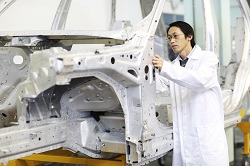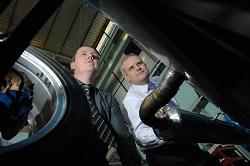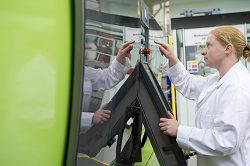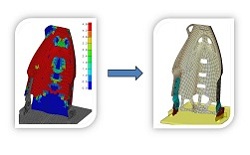Lighter: Vehicle Lightweighting
 Vehicle lightweighting is a key aspect of future vehicle R&D as increasingly stringent emissions legislation is enacted around the world - each 100kg of mass reduction can save 8g/km of CO2. This escalating legislation has proved to be a major driver of materials innovation in the automotive sector. WMG has built a long-standing capability in key aspects of lightweighting.
Vehicle lightweighting is a key aspect of future vehicle R&D as increasingly stringent emissions legislation is enacted around the world - each 100kg of mass reduction can save 8g/km of CO2. This escalating legislation has proved to be a major driver of materials innovation in the automotive sector. WMG has built a long-standing capability in key aspects of lightweighting.
WMG takes a holistic appraoch to lightweighting investigating the design, forming, joining and performance of materials. Our research focuses on solving the manufacturing challenges of volume application of advanced materials and the digital tools required to exploit new materials and technologies.
Lightweight Technologies Centre of Excellence
 WMG's applied research in lightweighting is routed through our WMG centre High Value Manufacturing Catapult programme.
WMG's applied research in lightweighting is routed through our WMG centre High Value Manufacturing Catapult programme.
The lightweight technologies researchers employ the latest design and modelling software to create lightweight structures from combinations of metals, alloys, polymers, composites, ceramics and hybrid materials. A key aspect of WMG's work is identifying and proving manufacturing processes that can be used to form and join novel combinations of materials to produce robust and reliable structures for practical application.
The Lightweight Technologies Centre includes specialist teams working on:
- Additive Layer Manufacturing solutions (polymers and metals)
- Metrology and Product Evaluation Technology
- Engineering Materials Manufacturing (design, manufacturing and functionality including system and vehicle level)
- Steels (next generation, high strength)
- Nanocomposites and Polymers (injection moulded reinforced by nanomaterials)
- Sustainable Materials (composites using natural fibres)
- Advanced Machining (ultrasound and cryogencis)
Visit: Lightweight Technologies Centre of Excellence>>
Case Studies
Many of the innovations developed as a result of our research have been adopted by automotive manufacturers and suppliers leading to cost reduction, weight saving and environmental benefits:
 |
Ultra Lightweight Race WheelThis project with Caterham Cars aimed to assess the feasibility of manufacturing a race wheel from carbon fibre. Typical wheel materials are steel, aluminium and magnesium. Carbon composites offer potential weight savings of 60% compared to these materials. Carbon fibre’s high specific properties, high environmental resistance and excellent fatigue resistance make it an ideal material to reduce the mass of vehicle components, thereby reducing vehicle emissions. The objective of this project was to design, optimise and manufacture a lightweight carbon fibre racing wheel rim for use on a Caterham sports car. |
 |
Metal-Polymer Hybrid Injection Mouldings for LightweightingThis was a collaborative project between a number of partners aimed at creating an injection moulding process for combining the strength properties of metal with the design flexibility and durability of plastic. The research concentrated on selection of the metal interface with the appropriate plastic to ensure full adhesion and compatible expansion of the two different materials. |
 |
Lightweight Seat Back ProjectThe Lightweight Technologies team at WMG worked with GRM Consulting to investigate ways to significantly reduce the weight of a car seat as well as reducing the environmental impact of manufacturing the seat. WMG’s approach was to characterise possible new candidate materials and then evaluate them against benchmark materials. The predicted performance was simulated using finite element analysis which enabled performance to be optimised. |
